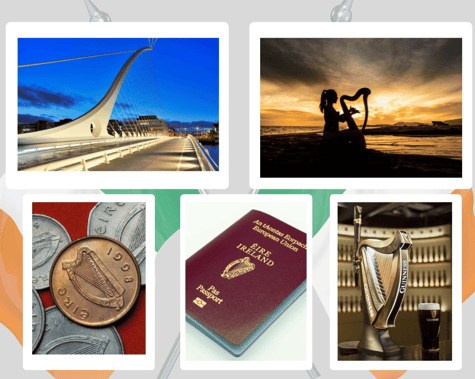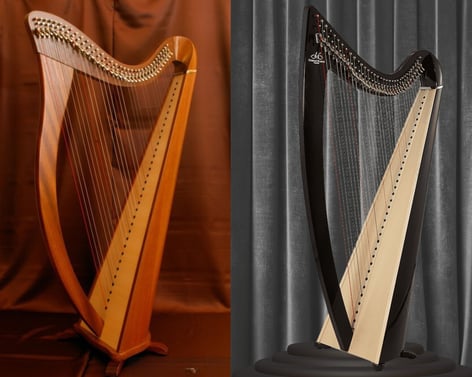
Discover Ireland
the magic island...
The harp is a national symbol.
The Irish harp is more than a musical instrument; it is a cultural treasure that resonates with the vibrations of Irish history and national identity. From its ancient roots to its vibrant presence today, the harp has woven a unique soundtrack that accompanies the nation through time.
A Journey Through the Ages:
The earliest Irish harps date back to the 8th century, intertwining with Celtic mysticism and legends. The figure of the god Dagda, with his magical harp that controlled the seasons, exemplifies the instrument's deep connection with the Irish essence.
An Echo of History and National Identity
A Living Legacy in the Present:
The Irish harp continues to thrive in the 21st century, captivating audiences with its evocative melodies and enchanting presence. Renowned harpists, such as Síle Denvir and Gráinne Yeats, carry on the tradition, inspiring new generations and showcasing the instrument's versatility and expressive power.
The symbol of the Irish harp is on coins, in the Irish passport, in the iconic and famous Guinness beer, also represented in bridges, undoubtedly a national symbol present, alive and super representative of Irish culture.
Just as in our country Paraguay is an important part of our culture the love for the harp, of course there are many differences between the Paraguayan and Irish weapon, but sharing a beautiful melody each with its unique sound is something that unites us.
A Symbol Unifying the Nation:
From the 13th century onwards, the harp became consolidated as a national emblem, adorning coins, coats of arms, and official documents, establishing itself as a tangible representative of Irish culture and history.
A Song of Joy and Unity:
Beyond a symbol, the harp is the musical voice of Ireland. Its melodious sound has accompanied festivities, celebrations, and moments of national unity, weaving a soundtrack of joy and social cohesion.
IRISH HARP
PARAGUAYIAN HARP
Irish Masters
Turlough O'Carolan (1670-1738): Considered the father of Irish harp music, O'Carolan composed over 200 tunes that are still performed and appreciated today. His unique style combined Irish tradition with influences from continental baroque music.
Edward Bunting (1773-1843): A musician and antiquarian, Bunting collected and transcribed a great deal of traditional Irish harp music, thus preserving a vital part of the country's cultural heritage. His work has been fundamental to the study and performance of Irish harp music.
O'Neill Family: Over several generations, the O'Neill family has been one of the most important in Irish harp music. From John O'Neill (1745-1818) to his grandson Francis O'Neill (1848-1936), this clan of talented harpists has contributed significantly to the evolution of the instrument and its repertoire.
Paraguayan Masters
Nicolás Sapucci (19th century): Considered one of the first great masters of the Paraguayan harp, Sapucci laid the foundations for the development of the modern style. He is credited with the incorporation of new techniques and the creation of a repertoire of emblematic pieces that are still performed today.
Félix Pérez Cardozo (1908-1982): A legendary figure in Paraguayan music, Pérez Cardozo took the Paraguayan harp to the world. His technical virtuosity and ability to compose beautiful melodies catapulted him to international fame. His masterpiece, "India", has become an unofficial anthem of Paraguay.
Digno García (1913-2001): A master innovator, García experimented with incorporating new rhythmic and harmonic elements into the Paraguayan harp. His unique style and approach to composition opened up new possibilities for the instrument.
Mastering the Harp: Ireland and Paraguay




Mis Noches sin tí - Luz Verón arpista Paraguayan en Dubai
Celtic Heart (PBS Special) "Kid ar an Sliabh" - feat. Harp Twins & Máiréad Nesbittolo –
New Artists from both countries. We love music.
info@paraguayosenirlanda.ie


Relationship with:
Web develop and content: Lucas Grisetti




